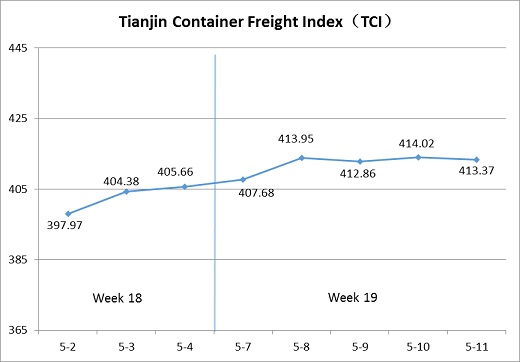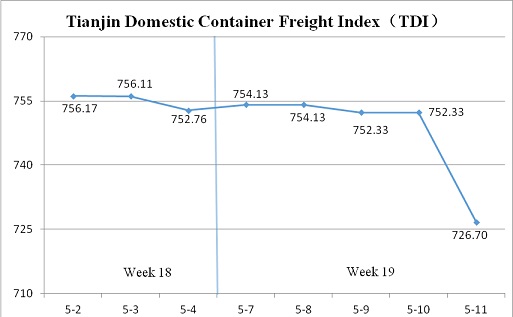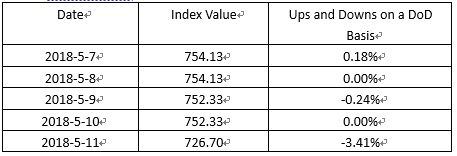Tianjin Shipping Index (May 7-May 11)
I. Tianjin Shipping Index (TSI)
In Week 19, 2018 (May 7-May 11), Tianjin Shipping Index increased early this week and then did not fluctuate obviously. Tianjin Container Freight Index (TCI) increased with shocks. Tianjin Bulk Freight Index (TBI) decreased markedly. Tianjin Domestic Container Freight Index (TDI) kept the rapid decrease trend of last week. The TSI closed at 604.16 points with an increase of 0.59% from May 4 (the last release day of Week 18). The TSI trend is as follows:

The chart above shows the trends of TSI from May 2 to May 11. The value of TSI in Week 19, 2018 is as follows:

II. Tianjin Container Freight Index (TCI)
In Week 19, 2018 (May 7 to May 11), the trend of TCI is as follows:

In week 19, the TCI reached a high point and then fluctuated slightly.
From May 7 to May 9(Mon. to Tue.), the freight rates in European Route, Mediterranean Route, South American West Coast Route, Central South American Route and India-Pakistan Route increased rapidly. The freight rates in North American Route and South American East Coast Route increased and then decreased. The TCI kept increasing by 2.04% on two consecutive release days. From May 9 to May 11(Wed. to Fri.), the freight rates in European Route, Mediterranean Route and South American Route kept decreasing. The freight rates in North American Route kept stable. The freight rates in India-Pakistan Route kept an increase trend. The TCI decreased by 0.14% on three consecutive release days with slight fluctuation.
The TCI closed at 413.37 points with an increase of 7.71 points (1.90 %) from May 4 (the last release day of Week 18).
The TCI index value saw several up and down on a day-on-day basis are as follows:

European/Mediterranean route During the peak season of shipping, the cargo volume increased steadily. The freight rates increased early this week. In latter part of April, the freight rate increased markedly by nearly 50 percent and pressure exists that it might decrease. In mid and latter half of the week, the ship owners decreased the freight rates slightly to maintain loading rate. The freight indices in European Route, Mediterranean East Route and Mediterranean West Route increased 1.85%, 5.44% and 1.94% respectively on a week on week basis.
North American route Because of China-US trade friction, factories sped up shipment recently. Besides, the ports in the U.S. were congested, which led to increase of freight rates. This week, the freight rates kept increasing and then presented a decrease trend. The freight indices in North American West Coast Route and North American East Coast Route increased 1.62% and 1.63% this week.
South American route Cargo volume kept stable. The ship owners reduced the transport capacity. Some shipping alliances carried out the freight-rate-rising plan. Early this week, the freight rates in South American West Coast Route and Central South American Route increased markedly. But the consensus to increase the freight rates was not reached, the freight rates decreased in latter half of the week. The freight indices increased 23.74% and 5.19% respectively on a week on week basis. In comparison, the freight rates in South American East Coast Route increased slightly early this week and then decreased by 7.70% on a week on week basis.
India-Pakistan Route Cargo volume increased. Because the freight rates were under a low level, some ship owners tried to raise the freight rates this week. The freight indices increased 8.97% on a week on week basis.
III. Tianjin Bulk Freight Index (TBI)
Week 19, 2018 (May.7 – May.11), Tianjin Bulk Freight Index (TBI) is shown as follows:

In week 19, the TBI was stable earlier this week and it first increased and then decreased later in the week.
From May 7 to May 8 (Mon. to Tue.), the freight rate of coal increased slightly, the freight rate of grain was stable as a whole and the freight rate of mineral ore decreased, which led the TBI to shock narrowly. Then, the freight rate of coal increased slightly, the freight rate of grain decreased with shocks and the freight rate of mineral ore increased continuously. TBI increased continuously from May 9 to May 10 (Wed. to Thur.) and the total increase was 3.53%.
On May 11 (Fri.), the freight rate of mineral ore decreased after hitting the high point. TBI decreased slightly and ended at 832.20 points with an increase of 23.17 (2.86%) from May 4 (the last release day of week 18).
TBI index value saw several ups and downs on a day-on-day basis, which is shown as follows:

TBCI increased slightly as a whole this week. TBCI ended at 630.38 points with an increase of 14.70 points (2.39%) from May 4 (the last release day of week 18). Domestic coal price increased and the deal of coal in Australia area was active, then the freight rate increased steadily. For the Panamax market, the Pacific market was stable as a whole and the freight rate of the DBCT to Tianjin route increased about 2.5%. For the Capesize market, the freight rate of Hay Point to Qingdao route increased significantly later in the week and it increased about 2.5% this week.
TBGI decreased with shocks this week. It ended at 687.85 points with a decrease of 0.79 points (0.11%) from May 4 (the last release day of week 18). The market in the Atlantic continued to be weak and carriers in the market were in oversupply. The freight rate of South America to Tianjin route decreased over 0.2%. The freight rate of US Gulf to Tianjin route decreased about 0.2%. By contrast, the Pacific market stabilized and increased and the freight rate of West America to Tianjin route increased about 0.5%.
TBMI decreased slightly earlier this week but increased fast later. It ended at 1178.36 points with an increase of 55.59 points (4.95%) from May 4 (the last release day of week 18). For the iron ore market, inquiries of Australian miners increased and the oil price increased sharply. The ship-owners had strong will to hold the price. The freight rate of West Australia to North China increased over 7.5%. For the remote mine, the freight rate of Brazil to Tianjin route increased slightly later in the week and the total increase this week was over 0.5%. As for nickel ore, the freight rate of Surigao to Tianjin route was almost the same as that in last week.
IV. Tianjin Domestic Container Freight Index (TDI)
Week 19, 2018 (May 7-May 11), the trend of Tianjin Domestic Container Freight Index (TDI) is shown in the chart below:

The TDI in Week 19 declined slowly at the beginning of the week, but dramatically at the end.
From May 7 (Mon.) to May 10 (Thur.), the Outward Index kept steady, but the Inward Index decreased after expereincing increasing, so the TDI, in the whole, declined slghtly. On May 11 (Fri.), though the Inward Index started to rise, the Outward Index sharply dipped, leading the TDI to decline 3.41% and finaly end at 726.70 points, 26.06 points (3.46%) less than that on May 4 (the last release day of Week 18).
The value of TDI ups and downs on a day-on-day basis is shown as follows:

Tianjin Domestic Container Outward Freight Index (TDOI) decreased rapidly this week, eventually closing at 852.51 points on May 11 (Fri.) and declining 57.60 points (6.33%) compared with that on May 4 (the last release day of Week 18). It was obvious that the supply exceeded the demand this week due to the contradiction between unsatisfying transaction rate and good transport capacity. The shipping companies all declined their freight to ensure the loading rate of their shipping space. Therefore, the freight of three routes, Tianjin-Quanzhou, Tianjin-Shanghai, and Tianjin-Guanghzou, all plummeted, and their freight rate indices decreased 12.45%, 2.07% and 5.51% respectively.
Tianjin Domestic Container Inward Freight Index (TDII) rose in stability this week, and closed at 600.89 points on May 11(Fri.), experincing an increase of 5.48 points (0.92%) compared with that on May 4 (the last release day of Week 18). Though the northern route market, this week, was gloomy, the frieht of Shanghai-Tianjin and Guangzhou-Tianjin, due to its original lower level, still went better, and the freight rate indices increased 0.13% and 1.88% separately. That of Quanzhou-Tianjin, by contrast, began to fall this week, and its index decreased 2.16% eventually.
HEADLINES
- Do shipping markets want Biden or Trump for the win?
- All 18 crew safe after fire on Japanese-owned tanker off Singapore
- Singapore launching $44m co-investment initiative for maritime tech start-ups
- Cosco debuts Global Shipping Industry Chain Cooperation Initiative
- US warns of more shipping sanctions
- China continues seaport consolidation as Dalian offer goes unconditional